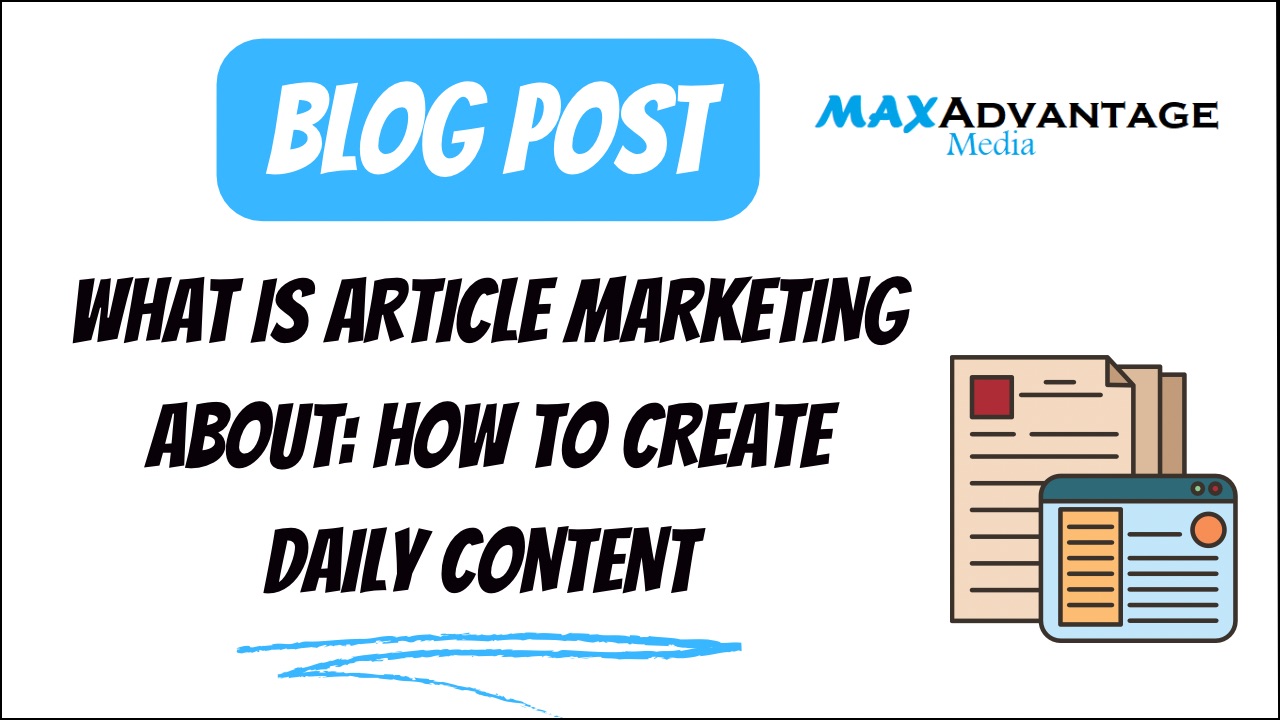 What Is Article Marketing About: How To Create Daily Content
What Is Article Marketing About: How To Create Daily Content
If you are looking expand you marketing efforts you may ask, what is article marketing about? But, don’t fret, we have the answers you seek. Article marketing is all about using written content to promote a business, service, or product by distributing valuable, informative articles. It’s been around for quite a while, adapting to the changes brought by the digital age. Back in the day, article marketing might have been about getting pieces into newspapers or magazines. Now, it’s more about publishing content online where people are already looking for information.
Additionally, article marketing focuses on educating an audience and earning their trust over time. Unlike traditional marketing, which might rely heavily on direct advertising or sales pitches. This approach can lead to building a dedicated reader base that returns for reliable content. Ultimately, the goal here isn’t just to push a product but to provide real value. By answering questions and solving problems for your audience, you naturally lead them to your business when they’re ready.
Furthermore, the advantages of using articles in marketing strategies are many. For starters, you get to showcase your expertise in your niche, showing potential customers why they should trust you. Articles can also significantly boost your SEO efforts since search engines love fresh, relevant content. In practice, this means more organic traffic to your site and better visibility overall. Plus, well-crafted articles can foster better engagement with users who’ve found your content useful. Encouraging them to interact and share it with others.
About Article Marketing: Why Daily Content Creation Matters
Consistency in content creation is essential for building a successful business digital presence and improving your website’s search engine rankings. Plus, daily content creation keeps your website fresh, which search engines like Google reward with better visibility in search results. In turn, this increases your chances of reaching your target audience more effectively.
Moreover, publishing content regularly allows you to engage with your audience and establish trust over time. Frequent updates show that your business is active and committed to providing value to its customers. As a result, your readers are more likely to return to your site for reliable information.
Additionally, daily content creation provides more opportunities to target high-traffic keywords relevant to your niche. By producing a steady stream of articles, you can cover a wide range of topics and expand your reach. Actually, this also helps you stay ahead of competitors who may be less consistent in their content efforts.
Specifically, creating content daily enables you to quickly respond to industry trends or audience feedback. By staying current, your business remains relevant and top-of-mind for potential customers. Helping you to increase inquiries and sales to your business.

Choosing The Right Topics For Article Marketing
Choosing the right topics is of utmost importance for the success of your article marketing efforts. In fact, the right topics attract your target audience and improve your SEO rankings. Therefore, focus on identifying your audience’s needs, interests, and common challenges. This helps you create content that provides real value and keeps readers engaged.
Next, use keyword research tools like Jaaxy, Google Keyword Planner to discover high-traffic keywords related to your industry. For quick wins, long-tail keywords are especially valuable because they often have less competition and higher conversion potential. By targeting these keywords, you can increase your chances of ranking well in search results.
Additionally, monitor industry trends and news to identify timely topics that will capture your audience’s attention. Trending topics not only boost traffic but also establish your authority as a knowledgeable source in your niche. So, don’t forget to keep an eye on what your competitors are writing about to spot content gaps you can fill.
Furthermore, it’s also essential to mix evergreen and timely content. Evergreen topics provide long-term value, while timely articles capitalize on current interest and urgency. This balance helps your content stay relevant and consistently drives traffic.
With this in mind, validate your topic ideas by asking if they align with your business goals and audience needs. If the topic doesn’t serve either, it’s time to revise and move on to a better topic cluster.
The Role Of E-E-A-T In Article Marketing
E-E-A-T stands for Experience, Expertise, Authoritativeness, and Trust, and these elements are foundational to successful article marketing. Therefore, understanding and applying E-E-A-T can significantly enhance the impact of your content, helping you connect meaningfully with readers.
Experience reflects the firsthand knowledge a writer brings to the table. So, this can be through sharing personal experiences, case studies, or insights directly from real-life engagement in the field. It adds authenticity to your articles, making them more relatable and credible.
Expertise is about demonstrating a solid understanding of the topics you cover. In effect, this means ensuring your content is well-researched, accurate and comprehensive. Readers are likely to return to sources that consistently provide expert insights and details.
Authoritativeness comes from being recognized as a reliable source within your industry. Overall, this involves building a reputation over time. Which can be supported by citing credible sources, receiving endorsements, or being widely referenced by others in your field.
Trust is arguably the most critical element, serving as the glue that holds the other aspects together. Thus, trust is earned by consistently providing reliable, valuable content. Therefore, ensuring transparency in your writing, like openly discussing both positives and challenges, strengthens this trust.
Ultimately, applying E-E-A-T in daily content creation involves a commitment to maintaining high standards. Actually, embedding these principles into your content strategy can lead to more profound engagement with your audience. Whether you’re a solo entrepreneur or part of a larger team. Consequently, you not only improve your content quality but also foster a loyal reader base that sees your articles as a go-to resource.
Different Types Of Article Marketing
Understanding the different types of article marketing helps you diversify your strategy and reach a wider audience. Overall, each type serves a unique purpose, allowing you to maximize engagement and SEO benefits.
1. Blog Articles
Blog articles are the foundation of most article marketing strategies. They allow you to publish valuable, informative content on your website. In addition, blogs improve SEO by targeting specific keywords and providing fresh content for search engines to index. Through these efforts, they help build trust with readers by offering solutions to their problems.
2. Guest Posts
Guest posts involve writing articles for other websites in your industry. This approach helps you reach new audiences and build backlinks. Plus, backlinks are important for improving your website’s domain authority and search rankings. Moreover, guest posting positions you as an expert in your field giving your business and website authority over competitors.
3. Press Releases
Press releases are another effective form of article marketing. They are used to announce news, events, or updates about your business. Therefore, when they are distributed through reputable channels, press releases can generate media coverage and backlinks. As a result, they boost both your visibility and credibility.
4. How-To Articles
How-to articles provide step-by-step instructions that solve specific problems for your audience. On balance, these articles are highly engaging and often shared widely. They also improve your SEO by targeting long-tail keywords related to your audience’s questions.
5. Listicles
Listicles, or list-based articles, present information in an easy-to-read format. This structure appeals to readers who prefer skimming content for quick takeaways. Therefore, listicles are also great for boosting engagement and driving traffic to your site.
6. Educational Articles
Educational articles dive deeper into topics and provide in-depth analysis or data. So, these are ideal for showcasing expertise and attracting a professional audience. Additionally, they also tend to perform well in organic search rankings.
Essentially, by incorporating these types of article marketing ideas into your strategy, you can reach diverse audiences and achieve better SEO results.

Creating High-Quality Articles That Rank
Creating high-quality articles is essential for improving search engine rankings and keeping your audience engaged. To succeed, prioritize delivering value over simply targeting keywords. Ultimately, search engines like Google reward content that is informative, well-structured and answers users’ questions effectively.
First, focus on writing clear and concise content that is easy to read. Therefore, break up large blocks of text with headings, bullet points, and short paragraphs. This structure makes your articles scannable and encourages readers to stay on your page longer.
Next, always back up your content with reliable sources and data. Including statistics, studies, or expert opinions enhances credibility and improves your article’s authority. As a result, your content is more likely to earn backlinks and rank higher in search results.
Additionally, craft compelling headlines that grab attention while incorporating relevant keywords. A strong headline increases click-through rates, which signals to search engines that your content is valuable. Also, use meta descriptions to summarize your article and entice readers to click.
Furthermore, optimize your content for SEO by naturally incorporating keywords throughout the article. However, avoid keyword stuffing, as it can hurt your rankings. Instead, use synonyms and related terms to keep your writing smooth and user-friendly.
For SEO purposes, include internal and external links in your articles. Internal links help readers navigate your site, while external links add value by connecting to authoritative sources. Moreover, these links also improve your SEO by creating a well-connected content structure.
Optimizing Articles For SEO
Optimizing articles for SEO helps your content rank higher in search engine results and reaches your target audience more effectively. Uniquely, it involves implementing specific techniques to make your articles both search-engine-friendly and valuable for readers. By following best practices, you can maximize your content’s visibility and engagement.
First, start by selecting a primary keyword that aligns with your article’s topic. Then, incorporate this keyword naturally into your title, headings and throughout the content. However, avoid overusing it.
Next, optimize your meta title and meta description. Actually, these are the first things users see in search results, so make them compelling and relevant. Therefore, include your primary keyword in both to improve click-through rates and search visibility.
Additionally, use proper heading tags (H1, H2, H3) to structure your content. Headings make your article easier to read and signal to search engines what each section is about. So, make sure that each heading contains a keyword or phrase related to the article’s topic.
Moreover, focus on writing high-quality, engaging content that keeps readers on your page longer. In fact, search engines consider time spent on a page when ranking content. So, use visuals like images, infographics, or videos to enhance readability and engagement.
Another important step is linking strategically within your article. In short, use internal links to connect to other relevant pages on your site, which helps readers explore more of your content. Also, include external links to authoritative sources, as they enhance credibility and support your claims.
Lastly, optimize your article’s images by using descriptive file names and adding alt text. This improves accessibility and allows search engines to index your images. Do so by, compressing images to ensure your page loads quickly, as site speed is a critical SEO factor.
By implementing these SEO optimization techniques, your articles will have a better chance of ranking higher and attracting more readers.
Distributing Your Articles For Maximum Reach
Distributing your articles effectively is imperative for reaching a larger audience and maximizing the impact of your content marketing efforts. In reality, even the best-written articles won’t drive traffic unless they are shared on the right platforms. So, by implementing a solid distribution strategy, you can increase visibility and engagement.
First, start by publishing articles on your website or blog, as this builds a central hub for your content. Also, optimizing your website for SEO ensures that search engines can easily index your articles, improving organic traffic over time.
Then, share your articles on social media platforms like Facebook, LinkedIn, and Twitter. Social media helps you reach a broader audience and encourages sharing, which amplifies your content’s exposure. Therefore, use eye-catching headlines and visuals to attract clicks and engagement.
Additionally, consider submitting your articles to content-sharing platforms like Medium or industry-specific forums. In effect, these platforms can connect you with niche audiences who are actively seeking valuable information. Therefore, make sure the content is tailored to each platform’s audience and guidelines.
Another effective method is email marketing. Share your latest articles with your email subscribers to keep them informed and engaged. Moreover, including links to your content in newsletters or promotional emails drives consistent traffic to your site.
Furthermore, leverage guest posting opportunities to distribute your articles on other high-authority websites. Notably, guest posts introduce your content to new audiences while building backlinks, which improve your domain authority and SEO rankings.
Finally, track the performance of your article distribution efforts. Use tools like Diib, and Google Analytics to monitor traffic, engagement and conversions. Overall, analyzing these metrics allows you to refine your strategy and focus on platforms that yield the best results.
Overcoming Common Challenges In Daily Article Creation
Facing writer’s block is something we all deal with when it comes to article writing. Actually, a great way to combat this is by setting a regular writing schedule and sticking to it. As routine can foster creativity. Also, when inspiration runs low, stepping away or engaging in a different creative activity can spark new ideas.
In addition, planning content efficiently is also key. Using a content calendar helps keep you organized and ensures a steady flow of topics to write about. This way, you’re not scrambling last minute to come up with ideas, which can compromise quality.
Also, balancing originality with quality under tight schedules can be tough. Therefore, it’s important to allow time for drafting and revising. In practice, producing quality content isn’t necessarily about speed but about crafting something meaningful and accurate.
Importantly, avoiding plagiarism is crucial to maintaining integrity and trust. Always ensure content is original and when citing others, do so with proper acknowledgment. After all, plagiarism not only hurts credibility but can also lead to serious legal issues.
In particular, content fatigue can arise when maintaining a daily writing habit. Therefore, it’s vital to diversify the types of content you produce and mix in lighter creative tasks. On balance, this keeps the process enjoyable, preventing burnout while maintaining quality.

Tracking The Performance Of Your Article Marketing Efforts
Tracking the performance of your article marketing efforts is essential for understanding what works and optimizing your strategy for better results. By analyzing key metrics, you can identify strengths, fix weaknesses, and make data-driven decisions to improve your content’s effectiveness.
In this case, monitor website traffic using tools like Goolge Search Console and Google Analytics. Pay attention to metrics such as page views, unique visitors, and time spent on each article. Overall, these insights reveal which topics resonate most with your audience and help you create more targeted content.
Likewise, evaluate engagement metrics such as bounce rate, click-through rate (CTR) and social shares. A high bounce rate may indicate that your content isn’t meeting user expectations. On the other hand, a strong CTR and frequent shares suggest your articles are compelling and valuable.
Additionally, track the number and quality of backlinks generated by your articles. Backlinks are a strong indicator of authority and play an important role in improving your search engine rankings. Therefore, use tools like Diib, Ahrefs or SEMrush to analyze your backlink profile and identify opportunities for improvement.
Furthermore, measure keyword rankings to determine how well your articles are performing in search engine results. Regularly checking your rankings helps you stay competitive and allows you to adjust your SEO strategy as needed.
Moving on, another important step is assessing conversion rates. This includes tracking how many readers take desired actions. In particular, things such as subscribing to your email list, downloading resources, or making a purchase. Ultimately, high conversions indicate that your articles are not only engaging but also driving business results.
Finally, use these insights to refine your article marketing strategy. Focus on topics, platforms, and techniques that yield the best results while improving areas that underperform. Continuously testing and adjusting your approach will ensure long-term success.
Tools And Resources To Enhance Article Marketing
Using the right tools can make article marketing smoother and more manageable. Content management systems like WordPress offer versatile options to organize, schedule, and publish articles efficiently. They’re user-friendly and packed with features that cater to writers at any level.
Also, analytics tools offer insights into how your articles are performing. Google Analytics, for instance, can help track visitor numbers, page views, and more. Ultimately, providing a detailed look at what’s working and what isn’t. These insights allow you to fine-tune your strategy based on actual data.
Looking forward, AI and automation are increasingly becoming part of content creation. Plus, tools like Grammarly aid in improving grammar and style, ensuring your content remains polished and professional. Meanwhile, AI writing assistants offer suggestions to overcome writer’s block or generate new content ideas.
Furthermore, resources for ongoing learning and development keep your skills sharp. Online course on platforms like Coursera or LinkedIn Learning can enhance your writing abilities or deepen your marketing knowledge. Thus, staying updated with industry blogs and latest trends can also inform your content strategy.
When scaling, exploring collaborative tools can boost productivity if you’re working with a team. Notably, platforms like Trello or Asana can help manage tasks and keep everyone on the same page. This helps ensure a fluid content production process.
Frequently Asked Questions (FAQ) About Article Marketing
What is article marketing and how does it work?
Article marketing involves creating and distributing articles to promote a business, improve SEO, and increase online visibility. It works by providing valuable content that engages audiences and earns backlinks, helping websites rank higher in search engines.
How often should I publish articles for effective marketing?
Consistency is key. Publishing articles daily or several times a week helps keep your content fresh and relevant for both search engines and your audience. The frequency should align with your resources and marketing goals.
Can article marketing help my website rank higher on Google?
Yes, article marketing is a powerful SEO strategy. By creating quality, keyword-optimized articles and distributing them across relevant platforms, you can generate backlinks, improve search engine rankings, and increase organic traffic.
Is article marketing still effective?
Absolutely! While digital marketing trends evolve, article marketing remains an essential tactic for building authority, providing valuable information, and boosting SEO through quality content.
How do I choose the right keywords for my articles?
Use keyword research tools like Jaaxy or Google Keyword Planner, to identify high-traffic, relevant keywords for your industry. Focus on long-tail keywords that are specific and aligned with your target audience’s search intent.
What are the benefits of guest posting as a form of article marketing?
Guest posting allows you to reach new audiences, build backlinks, and establish credibility in your niche. By contributing content to other authoritative websites, you can improve your SEO and drive referral traffic to your site.
How long should my articles be for optimal SEO?
Articles should generally be at least 1,000 words for better SEO results. Longer content tends to perform better in search rankings, as it can provide more value and cover topics in greater depth. However, quality should always come before length.
Can article marketing help build brand authority?
Yes, consistently publishing high-quality, informative articles helps position your brand as an authority in your industry. This can lead to increased trust from your audience and better organic search rankings over time.
What are the best platforms to distribute my articles?
Popular platforms include your own blog, guest blogging sites, content sharing sites like Medium, social media channels (LinkedIn, Facebook, Twitter), and article directories like EzineArticles. The key is to distribute your content where your target audience spends time.
How do I measure the success of my article marketing efforts?
Track key metrics like website traffic, engagement (e.g., time on page, bounce rate), social shares, backlinks, and keyword rankings. Tools like Diib, Google Analytics, Ahrefs, or SEMrush can help you monitor and adjust your strategy for optimal results.
Conclusion
Article marketing is a powerful strategy for boosting your online presence, engaging your audience and driving valuable organic traffic to your website. So, by consistently creating high-quality content, optimizing it for SEO, and distributing it effectively, you can build authority. In return, you can attract a loyal readership and increase sales.
For the best results, daily content creation is the key to staying relevant. This is done by targeting important keywords, and establishing a strong connection with your audience. With a strategic approach, you can produce articles that rank well, provide value, and encourage readers to take action.
Remember, success in article marketing doesn’t happen overnight. Therefore, tracking performance metrics and continuously refining your strategy will ensure long-term results. In practice, the principles outlined in this guide will help you achieve your goals. Whether you’re just starting or looking to improve your efforts.
With that said, now it’s your turn. Start implementing these strategies today and watch your article marketing efforts transform your digital presence.
Let’s Talk: Contact Tim @ MaxAdvantage Media Of Long Island
Ready to transform your online presence and drive business growth? Contact MaxAdvantage Media today and let’s build an Article Marketing strategy that takes your Long Island business to new heights!
Maximize your online visibility, elevate your search engine rankings, and become a local authority in your industry with MaxAdvantage Media’s expertly crafted SEO-driven business services. Contact us today to unlock the full potential of your online presence!
Web Page:
https://maxadvantagemedia.com/seo-services/
Phone:
Email:
Tim@MaxAdvantageMedia.Com
